With an Ebay description like the one below, it was fairly easy to identify that there was a good story associated with this telescope:

“A mid 19th Century English single draw brass and leather telescope, that belonged to Captain B.W. Bagley of Shoreham. He was the captain of the sailing barque ‘Mizpah’. The telescope was made by Blachford & Imray of London and is in very good clean condition, with nice clear optics. It has an integral sun hood with sliding lens protectors, both front and rear. It is engraved in copperplate writing Blackford & Imray London – Day or Night.
Captain Bagley married the daughter of a local shipbuilder William May. With his daughter Jane came the newly built 540 ton sailing barque Mizpah. The 146 foot (44m) Mizpah plied its trade to South America and beyond, rounding Cape Horn several times. Their first son was actually born on board and his name and details had to be written into a Death Certificate, with the word ‘Death’ crossed out and replaced by ‘Birth’.
It is a fine quality telescope with a fascinating history. Originally purchased at auction from the descendants of the Bagleys, the lot includes a copy of Ships Monthly magazine from May 1973, detailing the history of the ship.
Size extended: 6 x 92 cms.
Size retracted: 6 x 52 cms.”
The description came from an antique dealer in Plymouth, close to the port, called Parade Antiques. I found it a little sad to see it sold off through an antique shop, with such a story behind it, but the family still retain the oil painting of the ‘Mizpah‘, as shown on the front cover of the Ships Monthly journal of May 1973 (below).
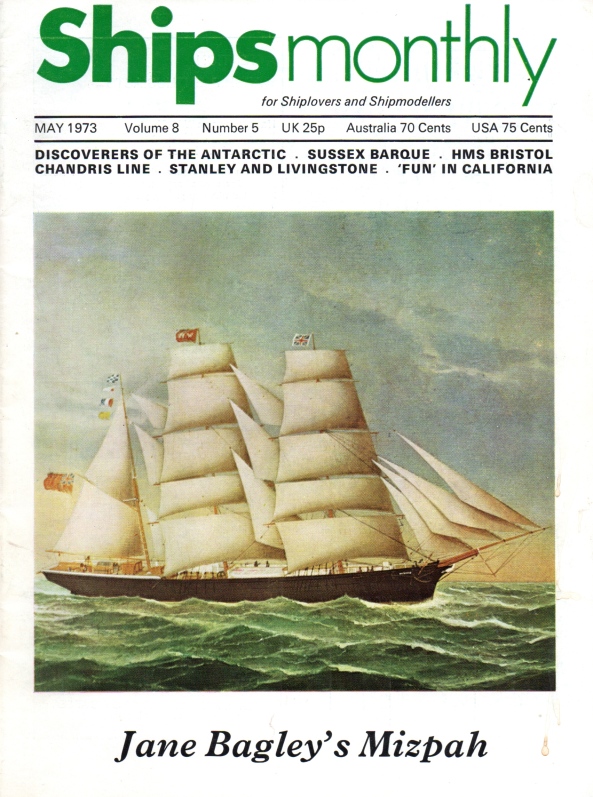
This is dated 12 February 1881, and shows the Mizpah off Heligoland under full sail. It was signed by two Hamburg artists, Peter Christian Holm and Heinrich Andreas Sophus Petersen, who were skilled in such paintings, normally done on commission by the ship’s owners or Captains.
The Mizpah
Launched in 1874, the Mizpah was the largest barque to be built at Shoreham, and the last to be built in the ‘Old Shipyard’ owned by William May. Subsequently two further barques were built, but they were the last of many that were constructed between about 1840 and 1875. Most of these barques, from 200 to 550 tons, were used for long distance trade, to the Pacific, America or the East Indies. It was estimated that around forty such Shoreham built wooden sailing ships were engaged in oceanic trade in 1874.
Mizpah was a square-rigged sailing barque, 550 tons on the Register, with a 950 ton carrying capacity. It had a length of 147 feet, breadth of 30 feet, and depth of 18 feet. The ship was owned by Mr May, the shipbuilder, with shares in the ship also owned by a Mr Wade and others: Mrs B Wade named and launched the ship on Saturday April 27th, 1874.
Captain B W Bagley had been previously based at Shoreham as his home port, when commanding the barque “Brighton“: this was built by William May, also owned by Mr Wade, and launched in 1871, for the Pacific trade. In sailing this for two years around Cape Horn and back, Capt Bagley had proved his seamanship and also presumably had developed a relationship with William and Jane May. When the Mizpah was launched and sent into this same trade route, Capt Bagley was to be the first commander, as well as the new son-in-law of the owner. He traded to South America and the Pacific for 12 years in the Mizpah, and during that time the ship was inspected by Lloyds, who classed it as in A1 condition.
Jane May, when Jane Bagley, sailed in the Mizpah with her husband: the barque had a crew of about 12. In December 1880, in the South Atlantic, Jane gave birth to their son on board the ship, at 19.33 S and 25.22 W. From 1874 the barques were overtaken as the most economic ships for this trade by iron built sailing ships, which were then superceeded in the 1880’s by larger mild steel sailing ships.
In 1886 the Mizpah was sold to a German firm, and by 1889 it had been sold to Norwegian owners, renamed as the Norden, had a Captain and owner named as T Jensen, with a home port of Rostock.
The Telescope
 The telescope is indeed in good condition, and complete with the lens slides etc. Capt Bagley did not go as far as having his name engraved on the telescope, nor the name of the Mizpah, so it just features the maker’s names, Blachford & Imray [Plus London, Day or Night].
The telescope is indeed in good condition, and complete with the lens slides etc. Capt Bagley did not go as far as having his name engraved on the telescope, nor the name of the Mizpah, so it just features the maker’s names, Blachford & Imray [Plus London, Day or Night].
Michael Blachford & Joseph Imray operated between 1836 and 1845, from 116 Minories, Tower Hill, London: so it was not new when Captain Bagley took over the Mizpah/married Jane May around 1874 (whichever came first on his ‘To Do’ list!).
Indeed we don’t know when Capt Bagley might have purchased the telescope. Whether he owned it for his voyages round the Horn is not known: it bears quite a few dents, but it is generally well looked after. Plus it works very well: the magnification is good, but not excessive: the field of view is also good, making the telescope easy to use. Whether this is all because it is a good example of Victorian over-engineering or not, is open for discussion.
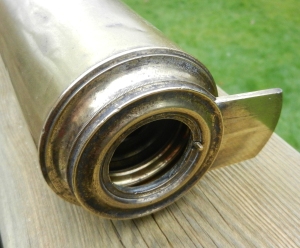 The complete thing weighs 1.25Kg, no lightweight to hold up for a while in a rough sea. OK, so you can balance it on the rigging. The largest diameter, on the barrel and sunshade, is 62mm. Dark brown leather covers the main wooden barrel structure underneath. This is used to support the main lens, the objective, which has a visible operating diameter of 39mm. But if the telescope is used with the end slider in place, and the slide is slid away to allow a view through the lens, the aperture available to accept light in the into the telescope through the slide assembly is only 28mm. So somewhere the aperture available for the optics in a 62 diameter telescope body has been restricted, so that we actually accept the light only coming into an aperture of 28mm, 45% of the telescope OD.
The complete thing weighs 1.25Kg, no lightweight to hold up for a while in a rough sea. OK, so you can balance it on the rigging. The largest diameter, on the barrel and sunshade, is 62mm. Dark brown leather covers the main wooden barrel structure underneath. This is used to support the main lens, the objective, which has a visible operating diameter of 39mm. But if the telescope is used with the end slider in place, and the slide is slid away to allow a view through the lens, the aperture available to accept light in the into the telescope through the slide assembly is only 28mm. So somewhere the aperture available for the optics in a 62 diameter telescope body has been restricted, so that we actually accept the light only coming into an aperture of 28mm, 45% of the telescope OD.
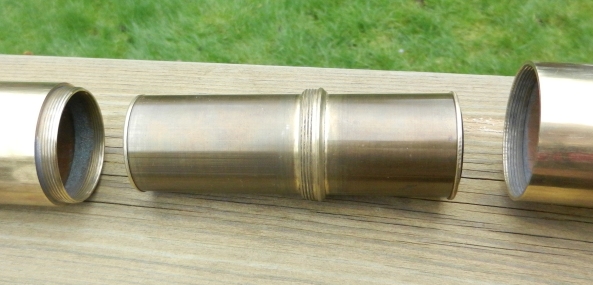
The central lens cartridge
Travel down to the eyepiece and the story is much the same. The drawtube has an OD of 45mm, but the lenses held within are mounted in separate ‘cartridge’ lens asemblies, with all the space these also need to position themselves inside the main body means the largest operating diameter of these lenses is 28mm. These cartridges themselves add significantly to the total weight of the telescope, the central cartridge is 100gms, and the eyepiece barrel 160 gms. The single drawtube, in two sections, is 575gms, because it has a 1.5mm wall thickness – but this means it is strong, and there is little damage from the use on-board ship to this drawtube.
Reference list:
 Ships Monthly journal, May 1973.
Ships Monthly journal, May 1973.
‘The Ships and Mariners of Shoreham‘, Henry Cheal Jnr, written 1909, published 2009: ISBN 978-1-906789-20-6.
‘Kapitansbilder‘, by Werner Timm, Rostock, 1971
BBC TV Flog It! Series 14 number 60.
Postscript 2016: BBC’s Flog It! programme
Admittedly I watch the BBC programmes Antiques Roadshow, Bargain Hunt and Flog It sometimes! The telescopes sold on Bargain Hunt are usually overpriced, when sold in the auction. The Roadshow has not shown any that I have seen, but they haven’t seen any decent ones, maybe.
But imagine my delight when the Flog It! programme, introduced by Paul Martin, on 2 November 2016 (recorded sometime in Summer 2015) showed this Blachford and Imray / Mizpah telescope being sold in a Plymouth auction room (Anthony Eldred’s saleroom). The programme was Series 14, Number 60, with the review of the products at Powderham Castle, in Devon.
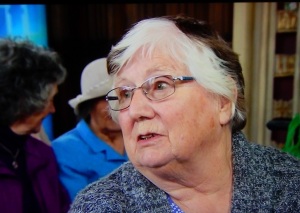 The lady with the nautical antiques was called Betty, and she brought in two sawfish (Carpenter shark) ‘rostrums’, plus the telescope, for sale. The expert, Will Axon, who apparently prefers English furniture, dismissed the telescope as a ‘working model’, and said collectors would not be interested. He obviously does not know anything about antique scientific instruments. Valuation was at first lumped together with the two rostrums (rostra?) at £150 max, but this was later split into two lots, with the scope valued £50-80.
The lady with the nautical antiques was called Betty, and she brought in two sawfish (Carpenter shark) ‘rostrums’, plus the telescope, for sale. The expert, Will Axon, who apparently prefers English furniture, dismissed the telescope as a ‘working model’, and said collectors would not be interested. He obviously does not know anything about antique scientific instruments. Valuation was at first lumped together with the two rostrums (rostra?) at £150 max, but this was later split into two lots, with the scope valued £50-80.
The telescope sold for a hammer price of £85, to a representative of Parade Antiques of Plymouth. It would be good to visit that auction house, if their clients value telescopes so poorly! He also bought the two ‘rostra’ nose extensions for £130.
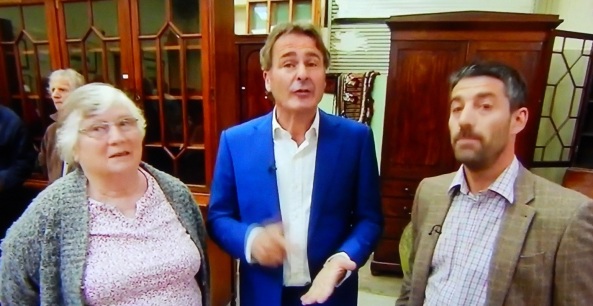
Betty, Capt Bagley’s Great Grand-daughter, with Paul Martin and Will Axon
The provenance of the telescope is recorded from Betty on the programme, in that it had been in a drawer for 125 years, but had belonged to her Great-Grandfather, presumably Captain Bagley, who had owned the telescope and also, she said, the ship the Mizpah. Plus he had brought back the Rostra. I hope Betty enjoys seeing the telescope shown on here, with its story, for more people to enjoy. I, as a telescope collector, snapped it up, as an excellently collectable piece, from Parade Antiques in Plymouth in September 2015: it is my accession number 246. While Betty sold the telescope for £85, which meant it cost Parade Antiques around £100 after the auction premium, they advertised it for sale at £385. I thought I bought at a fair price, at £300.
The photos below some screenshots taken from the programme, as shown by the BBC: they show the Auctioneer, Anthony Eldred; the winning bidder; the telescope (unpolished, as received after the auction); and one of the auction photos of the engraving –






 It is postulated that this telescope could have been bought from Spencer Browning & Co in the 1850s by a member of the Richards family, which would have been either John Richards the Elder of Borth (seven miles North of Aberystwyth) in Wales, or Evan Richards of Aberystwyth. In January 1845 John Richards the Elder had bought the locally owned ship known as the “Eagle”. This had been built 26 years before that, in 1819, at New Quay in Cardiganshire, now known as Ceredigion: it was a 31 ton sloop, fore and aft rigged with a running bowsprit, with a square stern, and carvel built, apparently with one mast, and one deck. Stem to stern was 38.4 feet, breadth 12.4ft, Depth at mid-ships in the hold 6.7ft. The history of New Quay website advises that 31 ships were built at New Quay during the period 1800-1820, most of which were Sloops- it was the standard vessel built in West Wales for the coastal trade. Similar vessel designs below 30 tons were known as ‘Smacks’.
It is postulated that this telescope could have been bought from Spencer Browning & Co in the 1850s by a member of the Richards family, which would have been either John Richards the Elder of Borth (seven miles North of Aberystwyth) in Wales, or Evan Richards of Aberystwyth. In January 1845 John Richards the Elder had bought the locally owned ship known as the “Eagle”. This had been built 26 years before that, in 1819, at New Quay in Cardiganshire, now known as Ceredigion: it was a 31 ton sloop, fore and aft rigged with a running bowsprit, with a square stern, and carvel built, apparently with one mast, and one deck. Stem to stern was 38.4 feet, breadth 12.4ft, Depth at mid-ships in the hold 6.7ft. The history of New Quay website advises that 31 ships were built at New Quay during the period 1800-1820, most of which were Sloops- it was the standard vessel built in West Wales for the coastal trade. Similar vessel designs below 30 tons were known as ‘Smacks’.




